
Unicorn Peak is a 6,971-foot (2,125-metre) mountain summit in Lewis County of Washington state, United States. It is the highest point in the Tatoosh Range which is a sub-range of the Cascade Range. It is located in Mount Rainier National Park, south of Mount Rainier. Precipitation runoff from the mountain's small glaciers, such as Unicorn Glacier, drains into tributaries of the Cowlitz River. The descriptive name is for the mountain's resemblance to the head and horn of a unicorn. The toponym was officially adopted in 1913 by the U.S. Board on Geographic Names.

Lane Peak is a 6,012-foot (1,832-metre) mountain summit in Lewis County of Washington state. It is situated on the crest of the Tatoosh Range which is a sub-range of the Cascade Range. It is located south of Mount Rainier within Mount Rainier National Park.
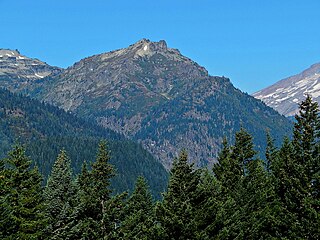
Stevens Peak is a 6,560-foot (1,999-metre) mountain summit in Lewis County, Washington, United States.
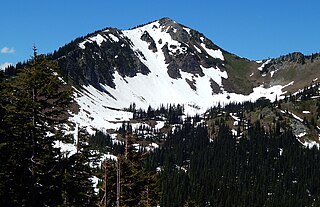
Dege Peak is a 7,006-foot summit located in Pierce County of Washington state. It is part of the Sourdough Mountains in Mount Rainier National Park. It was named in 1932 for James Henry Dege, a prominent Tacoma businessman and Captain of the First Regiment National Guard of Washington. His mother was a descendant of President Zachary Taylor.

Mount Fremont is a 7,214-foot-elevation mountain summit located in Mount Rainier National Park in Pierce County of Washington state. Mount Fremont is a minor peak at the southwest corner of the Sourdough Mountains which are a subset of the Cascade Range. It also the juncture for a small ridge of peaks of similar size running to the northeast. Mount Fremont is situated northwest of the Sunrise Historic District, with a popular trail leading to the Mount Fremont Fire Lookout. However, this trail does not reach the true summit which is 0.25 mi (0.40 km) north of Frozen Lake. Peak 7317, also known as Mount Fremont North, located 0.31 mi (0.50 km) west-northwest along the ridge is its nearest higher neighbor. Access is limited by snowpack closing the Sunrise Road much of the year. July, August, and September are typically the months when the Sunrise Road is seasonally open for vehicle traffic. Precipitation runoff from Mount Fremont drains into the White River.
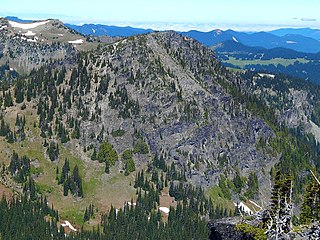
McNeeley Peak is a 6,786-foot-elevation summit located in Mount Rainier National Park in Pierce County of Washington state. It is part of the Sourdough Mountains, a subset of the Cascade Range. McNeeley Peak is situated north of the Sunrise Historic District, east of Mount Fremont, and northwest of Antler Peak. The peak was named in 1932 for Edwin J. McNeeley, a prominent Tacoma businessman. Access is limited by snow closing the Sunrise Road much of the year. July, August, and September are typically the months when the Sunrise Road is seasonally open for vehicle traffic. Precipitation runoff from McNeeley Peak drains into the White River.

Seymour Peak is a 6,337-foot-elevation mountain summit located in Mount Rainier National Park in Pierce County of Washington state. It is part of the Cascade Range and is situated southeast of Cayuse Pass and northeast of Shriner Peak. Its nearest higher neighbor is Dewey Peak, 0.79 mi (1.27 km) to the east. Precipitation runoff from Seymour Peak drains into tributaries of the Cowlitz River. Seymour Peak is named after William Wolcott Seymour (1861-1929), mayor of Tacoma, Washington, from 1911 to 1914. He was also a philanthropist, mountaineer, and a contributor to the scouting movement. This landform's toponym was officially adopted in 1932 by the U.S. Board on Geographic Names.

Chinook Peak is a 6,904-foot (2,104 m) summit located on the eastern border of Mount Rainier National Park. It is also on the shared border of Pierce County and Yakima County in Washington state. Chinook Peak is situated north of Chinook Pass on the crest of the Cascade Range. Its nearest higher peak is Crystal Mountain, 1.31 miles (2.11 km) to the north. Crystal Peak lies 0.75 miles (1.21 km) to the northwest, and Cupalo Rock is 1.0 mile (1.6 km) to the east-northeast. Precipitation runoff from Chinook Peak drains into tributaries of the White River and Yakima River.

Marcus Peak is a 6,962-foot (2,122 m) summit located in Mount Rainier National Park in Pierce County of Washington state. It is part of the Sourdough Mountains which are a small subset of the Cascade Range, and it is situated north of Dege Peak. The peak was named in 1932 for Marcus Whitman (1802–1847), an early pioneer and physician. The Whitman Glacier on Little Tahoma also honors him. Access to Marcus Peak is limited due to snow closing the Sunrise Road much of the year. July, August, and September are typically the months when the Sunrise Road is seasonally open for vehicle traffic. The nearest higher peak is Palisades Peak, 0.64 miles (1.03 km) to the north-northeast. Precipitation runoff from Marcus Peak drains into the White River.

Tamanos Mountain is a 6,790-foot (2,070 m) summit located in Mount Rainier National Park in Pierce County of Washington state. It is part of the Cascade Range. Tamanos Mountain is situated west of Governors Ridge and northeast of the Cowlitz Chimneys, all of which can be seen from the Sunrise Historic District. The name tamanos derives from Chinook Jargon and has the meaning of guardian spirit. This landform's toponym was officially adopted by the U.S. Board on Geographic Names in 1932. Topographic relief is significant as the summit rises 3,100 feet above the White River in approximately 1.5 mile. The normal climbing access is from the Owyhigh Lakes Trail, and from the lakes scrambling up the south slope to the summit.

Double Peak is a 6,199-foot (1,889 m) double summit mountain located in Mount Rainier National Park in Pierce County of Washington state. Part of the Cascade Range, it is situated northwest of Shriner Peak, south of Governors Ridge, and southeast of the Cowlitz Chimneys. Precipitation runoff from Double Peak drains into the Ohanapecosh River which is a tributary of the Cowlitz River. Topographic relief is significant as the summit rises 3,400 feet above the Ohanapecosh in one mile (1.6 km). The mountain's descriptive toponym was officially adopted in 1932 by the United States Board on Geographic Names.
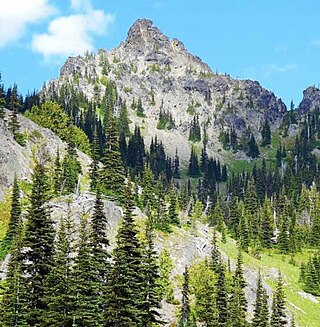
Three Way Peak is a 6,796 feet (2,071 m) summit located on the eastern border of Mount Rainier National Park. It is also on the shared border of Pierce County and Yakima County in Washington state. Three Way Peak is situated 0.42 mi (0.68 km) north of Cupalo Rock on the crest of the Cascade Range. Its nearest higher peak is Crystal Mountain, 0.56 mi (0.90 km) to the northwest. Chinook Peak is 0.8 mile to the southwest. Precipitation runoff from Three Way Peak drains into tributaries of the White River and Naches River.
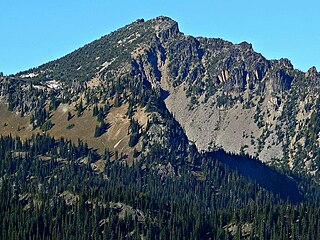
Palisades Peak is a 7,040-foot (2,146 m) summit located in Mount Rainier National Park in Pierce County of Washington state. It is part of the Sourdough Mountains, a subset of the Cascade Range, and is situated 0.6 mile north of Marcus Peak. The peak's descriptive name stems from the resemblance of its columnar basalt cliffs to a palisade. Access is via Palisades Lakes Trail which starts at Sunrise Point. Access to Sunrise Point is limited due to snowpack closing the Sunrise Road much of the year. July, August, and September are typically the months when the Sunrise Road is seasonally open for vehicle traffic. Precipitation runoff from Palisades Peak drains into the White River.

Wahpenayo Peak is a 6,231-foot (1,899-metre) mountain summit in Lewis County of Washington state, United States. It is part of the Tatoosh Range which is a sub-range of the Cascade Range. It is located south of Mount Rainier within Mount Rainier National Park. The mountain is named for Wahpenayo, a native American chief who was the father-in-law of Indian Henry. Precipitation runoff on the south and east side of the peak drains into tributaries of the Cowlitz River, whereas the north side drains into tributaries of the Nisqually River.
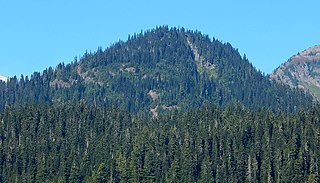
Buell Peak is a small 5,756 ft summit located in Mount Rainier National Park in Pierce County of Washington state. It is part of the Cascade Range and is situated 1.5 miles southwest of Cayuse Pass and 0.53 mile east-southeast of Barrier Peak, which is the nearest higher peak. Precipitation runoff from Buell Peak drains into tributaries of the Cowlitz River. The normal climbing access is from the Owyhigh Lakes Trail. The peak's toponym honors John Latimore Buell who arrived in Orting, Washington, in 1890 and went into the hardware business.

Copper Mountain is a 6,302-foot (1,921-metre) mountain summit located in Mount Rainier National Park in Pierce County of Washington state. Part of the Cascade Range, it is situated near the base of the Success Cleaver, overlooking Indian Henry's Hunting Ground. Its nearest neighbor is Iron Mountain 0.3 miles (0.48 km) to the south, and the nearest higher peak is Pyramid Peak, one mile (1.6 km) to the northeast. The summit provides views of Mount Rainier, Mount Adams, Mount St. Helens, and peaks of the Tatoosh Range. Precipitation runoff from Copper Mountain drains into Tahoma Creek and Fishers Horn Pipe Creek, which are both tributaries of the Nisqually River. There were great hopes in the late 1800s that mines on Mount Rainier could be a source of precious metals such as copper, silver, and gold. This landform's toponym was officially adopted in 1932 by the United States Board on Geographic Names.

Old Desolate is a 7,137-foot (2,175 m) multi-summit, ridge-like mountain located in Mount Rainier National Park, in Pierce County of Washington state. It is part of the Cascade Range, and lies five miles (8.0 km) due north of the summit of Mount Rainier. The Wonderland Trail provides an approach to this mountain, and the summit offers views of Sluiskin Mountain and Mount Rainier. Burroughs Mountain is the nearest higher neighbor, 2.37 mi (3.81 km) to the southeast. Precipitation runoff from Old Desolate drains east into the West Fork White River, or west into the Carbon River.

Goat Island Mountain is a 7,288-foot (2,221 m) ridge-like mountain located in Mount Rainier National Park, in Pierce County of Washington state. It is part of the Cascade Range, and lies 5.76 mi (9.27 km) east-northeast of the summit of Mount Rainier. This mountain is quite visible from the Sunrise Historic District and the many trails surrounding the Sunrise area. The Wonderland Trail provides an approach to this mountain, and the summit offers views of Cowlitz Chimneys, Fryingpan Glacier, and Mount Rainier. Burroughs Mountain is its nearest higher neighbor, 2.51 mi (4.04 km) to the northwest. Precipitation runoff from Goat Island Mountain drains into the White River. The mountain's descriptive name derives from mountain goats that were often seen on the peak. The toponym was officially adopted in 1932 by the United States Board on Geographic Names.
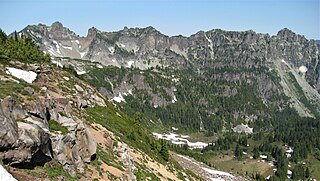
Mother Mountain is a 6,480+ ft multi-summit, 3-mile long ridge-like mountain located in Mount Rainier National Park, in Pierce County of Washington state. It is part of the Cascade Range, and lies 7 mi (11 km) northwest of the summit of Mount Rainier. The Wonderland Trail provides one approach option to this mountain, and the summit offers views of Mount Rainier. East Fay Peak is its nearest higher neighbor, 0.42 mi (0.68 km) to the south. Precipitation runoff from Mother Mountain is drained by Cataract Creek on the south side of the mountain, and Ipsut Creek drains the north side of it, and both are tributaries of the Carbon River. The west side drains into Mowich Lake, and thence Mowich River.
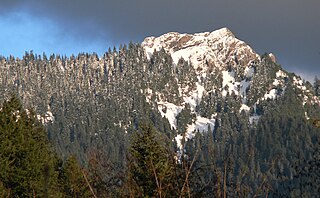
Mount Wow is a prominent 6,040+ ft mountain summit located in the southwest corner of Mount Rainier National Park, in Pierce County of Washington state. It is part of the Cascade Range, and lies 8.6 mi (13.8 km) southwest of the summit of Mount Rainier. Its nearest higher neighbor is Iron Mountain, 3.6 mi (5.8 km) to the east-northeast. Precipitation runoff from Mount Wow is drained by Tahoma Creek on the east side of the mountain, whereas Goat Creek drains the west side of it, and both are tributaries of the Nisqually River.

























